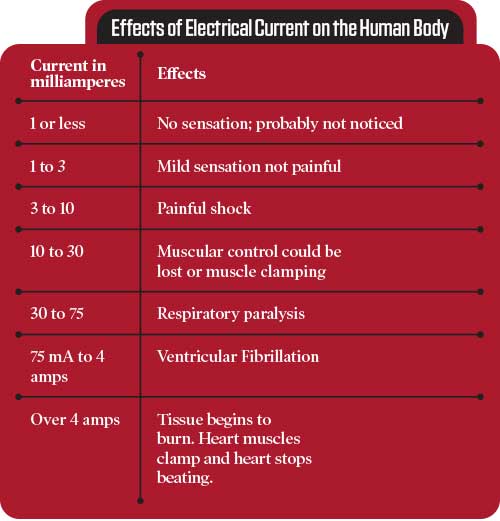The human body is a good conductor of electricity. As a result, electrical current can easily travel through it. There are three main types of electrical hazards: electric shock, electrical burns, and arc blasts (the effect of blasts). Understanding the basics of these hazards is critical in enforcing electrical safety in the workplace.
Electric Shock
Electric shock occurs when a body becomes part of an electrical current. Examples of electric shock include:
- A person may come in contact with both conductors in a circuit.
- Touching a live wire and an electrical ground.
- A person may provide a path between an ungrounded conductor and the ground.
- A person may provide a path between the ground and a conducting material that is in contact with an ungrounded conductor.
The severity of electric shock is related to four elements. If the combination of these four elements is just right, the shock can be severe or lead to electrocution.
- Amount of current
- Length of time current is present
- Path of current through the body
- Frequency of the current (Hz)
The amount of the current depends on the potential difference and the resistance. The effects of current on the human body range from a temporary mild tingling sensation to death. Voltage is important only in that it determines how much current will flow through a given body resistance. The current necessary to operate a 10 watt light bulb is eight to ten times more current than the amount that would kill a person. A pressure of 120 volts is enough to cause a current to flow which is many times greater than that necessary to kill.
Electrical Burns
The most common shock-related injury is an electrical burn. Burns suffered in electrical accidents can be of three types:
- Electrical Burns — the result of the electric current flowing in the tissues. These burns may be skin deep or may affect deeper layers such as muscle and bones.
- Arc Burns — the result of high temperatures produced by electric arcs or by explosions close to the body (see electrical arc blasts).
- Thermal Contact Burns — burns normally experienced from the skin-contacting hot surfaces of overheated electrical conductors, conduits, or other energized equipment.
Tissue damage is caused by heat generated by the current through the body and is often immediately classified as a third-degree burn. If the energy delivered by the electric shock is high, the body cannot dissipate the heat, and the tissue is burned. Typically, such electrical burns heal slowly.
Electric Arc Blasts
If the current is strong enough, the blast effect that can result from arcing can cause injuries and start files. The power arc is a discharge of electricity through a combination of ionized air and vaporized conductor material. The conductive material is vaporized by temperatures in an arc which can be as high as 35,000°F.
- Low-energy arcs can cause violent explosions or blasts in atmospheres containing explosive gases, vapors, or combustible dusts.
- High-energy arcs can also damage equipment causing metal to fly in all directions.
While there is no equipment that can completely protect electrical workers, there are several safe practices that can help.
- Limit Exposure. Reduce the amount of time spent around high energy equipment.
- Maintain Distance. Always stay as far away as possible from high-energy equipment unless there is a specific need.
- Increase Mass. Try to keep some type of sturdy material between you and a potential blast.
- Wear Protective Clothing. PPE such as flash suits may offer some protection to minimize burns resulting from blasts.

![Understanding the 3 [Main] Types of Electrical Hazards](https://iaeimagazine.org/wp-content/uploads/2020/04/2020_05_Cheatsheet_3_Types_of_Electrical_Hazards.jpg)










Find Us on Socials